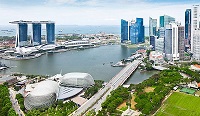My secondment to the International Energy Agency (IEA) in 2017 certainly stands out to me. It was an eye-opening experience to learn from many global experts and to be able to demonstrate that Singapore has valuable contributions to global discussions.
Another important milestone was the announcement of the Singapore Energy Story in 2019 and the Four Switches we are harnessing to decarbonise the energy sector. The announcement marked the culmination of over a year's work and served as the foundation for developing our subsequent strategies for the energy sector.



















